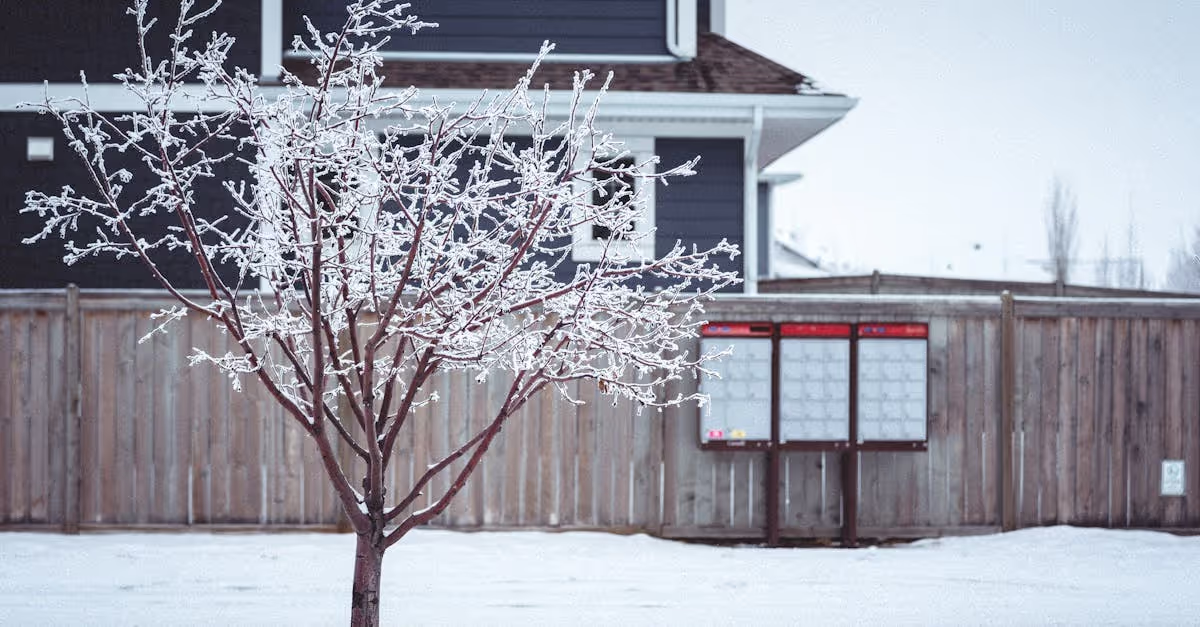Key Takeaways
- Proper Winterization is Essential: Closing a pool correctly prevents freezing damage, saving homeowners from costly repairs that average around $1,500.
- Step-by-Step Process: Key tasks include thorough cleaning, balancing water chemicals, lowering water levels below the skimmer, and properly covering the pool.
- Cost-Effective Solutions: DIY winterization methods can save significant costs, ranging from $150 to $450, while budget-friendly supplies like winter covers and chemical kits streamline the process.
- Invest in Quality Equipment: A snug-fitting winter cover and effective winterizing chemical kits are crucial for protecting the pool and reducing springtime maintenance.
- Utilize Technology: Service business software can automate tasks, manage chemical inventories, and simplify scheduling for professional winterization services if needed.
- Preventative Maintenance: Regular checks and proactive steps during winterization keep pools in good condition, ensuring an enjoyable swimming experience when spring arrives.
As the temperature drops and autumn leaves begin to fall, it's time to think about closing our residential pools for the winter. Did you know that improperly winterizing a pool can lead to costly repairs, averaging around $1,500? By taking the right steps now, we can save both time and money while ensuring our pools are ready for spring.
Overview of Pool Closing
Closing a residential pool for winter involves several key steps. Preparing our pool now saves us time and money come spring. A well-executed winterization process protects our investment. By following efficient methods, we keep repair costs low and minimize the hassle of reopening.
First, we need to clean the pool thoroughly. Removing leaves and debris prevents buildup that leads to algae and stains. After cleaning, we lower the water level. Keeping it below the skimmer helps avoid freezing damage. Also, it's important to blow out the plumbing lines. This prevents water from freezing inside the pipes.
Next, we focus on applying a winterizing chemical kit. This kit balances the water chemistry, ensuring the pool remains clear over the winter months. After chemical treatment, we cover the pool with a high-quality winter cover. The cover keeps out debris and sunlight that fuels algae growth. This simple step makes reopening easier.
Investing in the right equipment aids in a smooth closing process. Cost-effective tools like pool covers or winterizing kits streamline our task. Using a winter cover pump helps prevent water accumulation on the cover. This keeps the cover in good shape and limits chances of damage.
For those among us who enjoy technology, employing service business software can further ease the closing process. Automated field service solutions assist in managing tasks efficiently. Using job scheduling software simplifies scheduling winterization services with a professional. This is beneficial if we're not comfortable or lack the time to close the pool ourselves.
During this winterization process, we may ask ourselves questions. Do we need to schedule a maintenance visit? What equipment can simplify our pool closing? Reflecting on these questions can help identify any additional needs we have.
While the process may seem overwhelming at times, the rewards are clear. Winterization ultimately saves us from costly repairs. We enjoy peace of mind, knowing our pool is ready for spring without headaches. So let's tackle this together, organized and ready, to ensure our pools are safe, sound, and ready for warmer weather.
Importance of Closing Pools for Winter
Closing and winterizing our residential pools is crucial for protecting our investments and maintaining safety. Taking these steps prevents potential damage and keeps our pools ready for the warm weather when it returns.
Preventing Damage
Winterization prevents freezing temperatures from damaging pool components. Water expands when it freezes, putting pressure on pipes, pumps, and filters. This pressure can lead to cracks and leaks. According to experts, failure to winterize can result in average repairs that reach $1,500. By lowering water levels below the skimmer and blowing out plumbing lines, we mitigate this risk. It’s a proactive approach that saves us from costly repairs and ensures our pools remain functional. Using mobile workforce management tools can help track the winterization process, making it easier to schedule and complete the necessary steps.
Reducing Chemical Costs
Maintaining water quality during the winter months reduces our chemical costs. Proper winterization prevents algae growth, which requires fewer chemicals in the spring. Utilizing a winterizing chemical kit helps balance pool water chemistry and keeps debris at bay. With the right preparation, we avoid the hassle of extensive cleaning and adjustments come springtime. Investing in service business software can automate monitoring and manage our chemical inventory efficiently. This technology allows us to enjoy peace of mind while keeping our pools in optimal shape for the next swim season.
By taking these proactive steps, we save time, money, and effort, transforming winterization from a chore into a straightforward process. Who wouldn't want to kick back and enjoy their summer pool without worry?
Step-by-Step Guide to Closing Residential Pools
Closing our residential pools for the winter requires precise steps to make the process smooth and cost-effective. We can dive right in with the following key tasks.
Cleaning the Pool
We start by removing all leaves, silt, and other floating debris. A leaf net works wonders to clear the surface. This step prevents staining and contamination of the pool. Next, we vacuum the pool thoroughly, focusing on the floor and walls. A swimming pool vacuum, set to the waste setting, bypasses the filter to avoid pushing any algae back into the pool. Finally, we grab a pool brush to scrub the walls and floor, eliminating algae and bacteria. This simple action helps maintain clean water and stops mold from taking hold during the colder months.
Balancing Chemicals
We take time to check and balance the pH and alkalinity levels in the water. Keeping these levels in check means preventing issues like corrosion or scaling over the winter. It’s wise to apply a winterizing chemical kit to stabilize the water. These kits typically include products that will keep our water clear and safe, minimizing the need for spring cleaning. Having the right balance saves time and expenses, as it avoids costly repairs in the future.
Draining and Covering
We need to lower the water level below the skimmer to prevent freezing damage during winter. Draining too much can cause stress on the pool structure, so we find a sweet spot. Next, blowing out the plumbing lines keeps water from freezing inside the pipes. A quality winter cover protects our pool from debris and harmful UV rays. But let’s be honest—putting that cover on can sometimes feel like wrestling with an octopus! Remember, a good cover makes reopening easier in the spring, so it’s worth the effort.
By following these steps, we contribute to keeping our pools safe, clean, and ready for the next swim season. Embracing these tasks together makes for a great winter prep routine. What techniques do you use to close your pool?
Cost-Effective Methods
We can adopt several cost-effective methods when closing our pools for winter. These approaches help save money while maintaining our pools effectively.
DIY Solutions
Closing the pool ourselves can save between $150 and $450, which adds up quickly. First, we need to test the water, balancing pH, alkalinity, and calcium hardness for proper winterization. Cleaning the pool is essential too; we should remove leaves and debris using a rake or skimmer. Vacuuming the pool and scrubbing the walls will prevent algae growth and stains, making the spring opening much simpler. Think of it this way: tackling these tasks ourselves means we can enjoy ice-cold drinks and cozy sweaters without worrying about hefty repair bills.
Budget-Friendly Supplies
Investing in the right supplies keeps our winterization budget-friendly. A good winter cover is key to keeping debris out—choose one that fits snugly to shut out sunlight. Chemical kits designed for winterization help maintain proper water balance while preventing algae growth. We can also consider service business software to track our chemical usage and ensure we're stocked up. By employing these tools, we can simplify our winterization process significantly. And let’s be honest: nothing beats the satisfaction of seeing a clean, well-prepped pool before it goes into hibernation mode.
Efficient Techniques
Efficiently closing our residential pools for winter requires careful planning and attention to key techniques.
Proper Drainage
Proper drainage prevents freeze damage. We should lower the water level below the skimmer to avoid water expanding in the pipes. Draining helps avoid costly repairs, making our winterization efforts more economical. We can use a submersible pump for efficient drainage or simply siphon out water. Regular checks help find hidden pockets of water in the plumbing lines. Blowing them out with an air compressor is the best way to clear out any remaining moisture. This step protects our investment—no one wants a surprise repair bill come spring.
Cover Selection
Choosing the right cover is crucial for pool winterization. A snug-fitting winter cover keeps out debris, sunlight, and aquatic life. Opting for a solid cover over a mesh type reduces the need for cleaning in the spring. Covers with straps or weights can also withstand winter winds. We’ll find options that fit our budget and our pools, and the right cover can last multiple seasons. With the right selection, we save time and effort when it’s time to reopen.
Conclusion
Taking the time to properly winterize our pools can save us from significant repair costs and ensure a smooth reopening come spring. By following the outlined steps and investing in the right tools, we can efficiently protect our pools from harsh winter conditions.
Let’s remember that a little effort now translates to a hassle-free experience later. Embracing cost-effective methods and technology can simplify the process, allowing us to enjoy peace of mind during the colder months. With our pools well-prepped for winter, we can look forward to a refreshing swim when warmer days return.
Frequently Asked Questions
Why is it important to winterize my pool?
Properly winterizing your pool helps prevent costly repairs, averaging around $1,500. It protects your investment by avoiding freeze damage and ensures your pool is ready for spring.
What are the key steps for winterizing a pool?
Key steps include cleaning the pool, lowering the water level below the skimmer, blowing out plumbing lines, applying a winterizing chemical kit, and covering the pool with a high-quality winter cover.
How does cleaning my pool help in winterization?
Cleaning your pool prevents algae growth and stains, which can become problematic during winter. A clean pool simplifies the reopening process in the spring.
Why is balancing water chemistry necessary before winterizing?
Balancing water chemistry prevents corrosion or scaling on pool surfaces and equipment, ensuring they remain intact throughout the winter months.
How can I lower the water level in my pool for winter?
You can lower the water level using a submersible pump or siphoning water. Ensure it is below the skimmer to prevent freezing damage.
What is the importance of covering the pool for winter?
A good winter cover keeps debris and sunlight out, making it easier to reopen your pool in spring. It also protects against harsh winter conditions.
Can I winterize my pool myself?
Yes, many homeowners can winterize their pools themselves by following step-by-step guides. Utilizing tools can simplify the process, making it manageable.
What tools should I invest in for winterizing my pool?
Consider investing in a high-quality winter cover and a submersible pump. These tools streamline the closing process and help protect your pool from winter damage.
How does winterization affect spring maintenance?
Proper winterization reduces the need for extensive cleaning and chemical adjustments in spring. This saves time, effort, and money when reopening your pool.
Should I consider professional winterization services?
If you're uneasy about DIY methods or lack the time, professional winterization services can ensure your pool is properly prepared for winter, giving you peace of mind.






